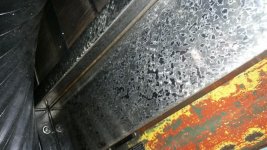shapeaholic
Stainless
- Joined
- Oct 14, 2003
- Location
- Kemptville Ontario, Canada
I have been working on the bed of my Smart and Brown 1024 Lathe, and have gotten to a point where I need to smooth the scraping marks.
The bed is VERY hard, and it just sort-of laughs at regular stones. ( makes you wonder how it got worn in the first place??)
In another thread Richard King referred to using a diamond lap to do this smoothing.
Can anyone enlighten me on how to make a lap and what grade diamond I should use to charge it?
Thanks
Pete
The bed is VERY hard, and it just sort-of laughs at regular stones. ( makes you wonder how it got worn in the first place??)
In another thread Richard King referred to using a diamond lap to do this smoothing.
Can anyone enlighten me on how to make a lap and what grade diamond I should use to charge it?
Thanks
Pete



